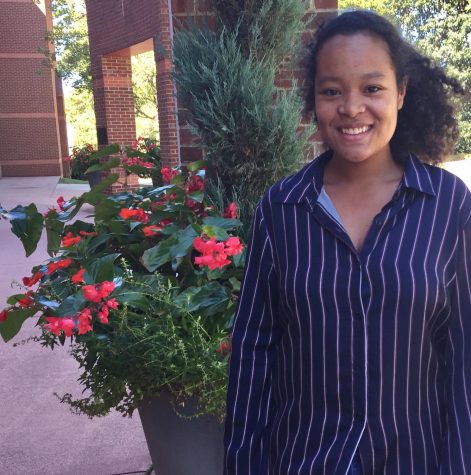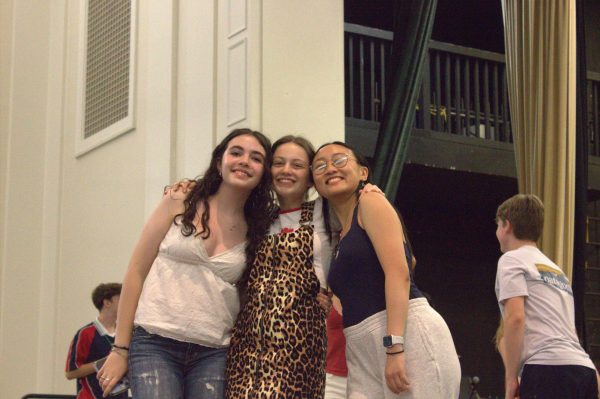Cyan D’Anjou’s artwork changes focus to 3-D pieces
On the Westminster campus, art takes on many shapes, forms, and sizes, interacting from the artist to the viewers in a unique exchange of intent and interpretation. Senior Cyan D’Anjou, an experienced artist, uses her artwork and builds award-winning installations that explore the connection between the two parties.
D’Anjou’s life has always been occupied by her artwork. She has enrolled in Drawing and Painting classes ever since seventh grade, both inside and outside of the Westminster campus, and is now taking the AP Studio Art 3-D Design class.
“The course is pretty fun, but challenging too since 3-D is new for me,” said D’Anjou. “I’ve always done 2-D, but I love seeing the different outcomes and working with different mediums.”
In this advanced studio arts class, students must work with a very limited time frame to plan and create complex sculptures while paying attention to the technique and details. At the end of the year, students will create a portfolio of 20 pieces of their best work.
“[The AP art students] have to pay very close attention to the craft and how they’ve made something,” said Benjamin Steele, the teacher of AP 3-D class that D’Anjou takes. “One of the goals is getting students to think quickly and work on a number of things at the same time, which is definitely something that all of them will be able to utilize when they create whole bodies of work.”
The other students agree with the difficulty of AP art classes as well.
“It is definitely a lot of work. The workload and time commitment alone rival that of any other AP class. the content is challenging as well,” said senior Madison Patton, an AP student and peer of D’Anjou. “Although we aren’t learning information in the traditional sense, creating an AP portfolio that is well executed and gets a high AP score is very hard.”
All of D’Anjou’s art experience over the years guides her and enables her to create massive installations and intricate art projects.
“[The artwork] comes from me thinking of a word and making it into an idea and building it,” says D’Anjou. “They vary a lot, so based on my design, it becomes the type of installation that fits the idea the best.”
Her inspiration comes from her family in the Netherlands. Her uncle is a professional sculptor, and her family offers the studio, resources, and knowledge that D’Anjou can use for her artwork. This studio is where she can best imagine and execute an idea.
Even talented artists meet artistic blocks, though, and D’Anjou likes to turn to her older pieces for inspiration, or paint out a quick and casual abstract piece to get her into the mood for creativity and design.
All of D’Anjou’s masterpieces include exploration with different materials in different mediums, and material and human movement. Her recurring theme, however, is not an object, abstract or concrete, that can be represented in the painting, but what the audience gets and thinks from her work.
Unlike many artists, who want to give off a message from their artwork to the audience, D’Anjou focuses on the communication from the drawer to the viewer, and the interaction they can access through her many pieces.
“What I think is the most interesting part of making art is that when people are looking at your work, they will put in their own interpretation of the art based on their own life,” said D’Anjou. “I don’t want to put anything on them, because it’s interesting about the dialogue of my intention and their interpretation. What I like to do is to be able to talk to the viewers about it and what they think.”
D’Anjou has participated in and won several national and international competitions, earning her the opportunity to display her artwork in many major galleries across the globe.
One of the most impressive examples is the Saatchi Gallery Art Prize for Schools, one of the largest international competitions in the world open to primary and secondary schools.
In early 2017, when D’Anjou applied, over 24,000 applicants from 66 different countries sent in their artwork to Saatchi Gallery, and 20 were selected to display their artistic masterpieces in the art museum in London. D’Anjou’s piece, named Lucifer (Matchsticks), was one of them. Her masterpiece was a sculpture of two matchsticks, yet they were huge and life-sized. One matchstick was unused and perfect, and the other lay on the ground with dark, burned wood.
“She won that really prestigious award, which is really impressive,” said Steele. “It’s a simple idea, but very well made, and when you encounter it, it seems like kind of a whimsical and unexpected thing since it’s a matchstick, but so so big.”
Additionally, D’Anjou has participated in the High Museum Factory Show, and two pieces, named Sleeping and Drowning and We are Powerful, are being displayed in the museum.
On campus, D’Anjou incorporates her drawings and paintings into student life as well, as she focused on the AP art show this year and displayed her colorful self-portrait in the college counseling office.
“I don’t do it really do it for the achievements, I do it for the art, and the chance to create something new that could impact lives,” said D’Anjou. “Art has always been my escape, and it’s something I do whenever I have time.”






